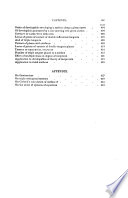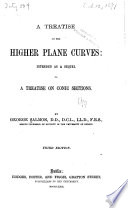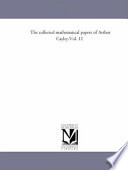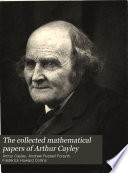 | George Salmon - Conic sections - 1852 - 338 pages
...ju2),~2. We see thus (as we found already, Art. 26) that the 3/> points, •where the curve of the pih degree meets the cubic, are such, that all but one...intersection. The tangents will be 2a2L - 3a2R + M = 0, 2j32L - 3/32R + M = 0, where a + /3 + 7 = 0, and j is known. We eliminate a, |3 thus : first, subtract... | |
 | George Salmon - Conic sections - 1852 - 329 pages
...be R 3 R We see thus (as we found already, Art. 26) that the op points, where the curve of the p th degree meets the cubic, are such, that all but one...locus of their intersection. The tangents will be 2a 3 L - 3a 2 R + M = 0, 2/3 3 L-3j3 2 Rf M=0, where a + j3 + 7 = 0, and y is known. We eliminate a,... | |
 | Bartholomew Price - Calculus - 1857 - 658 pages
...through these several pairs ; and as these lines arc not tangents in the ordinary meaning of the word, the number of tangents which can be drawn to the curve from a given point is to be diminished by three for each cusp. Hence if a curve has K cusps, the number... | |
 | George Salmon - Geometry, Analytic - 1862 - 490 pages
...satisfythat equation. This problem will have a definite number of solutions, and the number will plainly be the number of tangents which can be drawn to the curve from an arbitrary point; that is to say, the class of the curve. For example, the envelope of the line act*... | |
 | George Salmon - Geometry, Analytic - 1862 - 506 pages
...that equation. This problem will have a definite number of solutions, and the number will plainly be the number of tangents which can be drawn to the curve from an arbitrary point; that is to say, the class of the curve. For example, the envelope of the line where... | |
 | George Salmon - Curves, Algebraic - 1879 - 424 pages
...determine indirectly the number of double tangents of a curve of the «th order. The equation of the system of tangents which can be drawn to the curve from any point x'y'z, may be derived from the equation A=0 by the method used (Conies, Arts. 92, 294). Any point on... | |
 | Arthur Cayley - Mathematics - 1896 - 663 pages
...number of inflexions, and number of double tangents, — first, as regards the class, this is equal to the number of tangents which can be drawn to the curve from an arbitrary point, or what is the same thing, it is equal to the number of the points of contact of... | |
 | Arthur Cayley - Mathematics - 1896 - 676 pages
...number of inflexions, and number of double tangents, — first, as regards the class, this is equal to the number of tangents which can be drawn to the curve from an arbitrary point, or what is the same thing, it is equal to the number of the points of contact of... | |
 | Henry Frederick Baker - Geometry - 1922 - 270 pages
...the curve (other than at the multiple points), no one of which is common to all of them. Also that the number of tangents which can be drawn to the curve from an arbitrary point is 2m + 2p — 2. We have also shewn that the theory, for a curve whose multiple... | |
| |